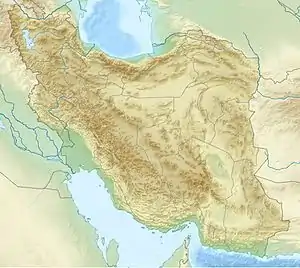Tureng Tepe
Tureng Tepe (Persian: تورنگ تپه, "Hill of the Pheasants";[1] alternatively spelled in English as Turang Tappe/Tape/Tappa/Tappeh) is a Neolithic and Chalcolithic archaeological site in northeastern Iran, in the Gorgan plain, approximately 17 km northeast of the town of Gorgan. Nearby is a village of Turang Tappeh.
 Location in Iran | |
| Coordinates | 36°56′17.95″N 54°35′11.47″E |
|---|---|
| History | |
| Periods | Chalcolithic and Bronze Age |
| Site notes | |
| Excavation dates | 1931, 1963-1979 |
| Archaeologists | Frederick Wulsin, Jean Deshayes |
Archaeology
.jpg.webp)
Tureng Tepe consists of a group of mounds interspersed with ponds and water courses. The whole archaeological pattern is about 900 meters in diameter. Most of the mounds rise between eleven and fifteen meters above the level of the surrounding plan, but the steep central mound, marked A on the Wulsin's plan, is over 30 meters high and dominates the entire site. A small modern village lies at the foot of the large mound.[2]
In 1841, some material (including gold vessels) from the site was sent to the Shah (Mohammad Shah Qajar), and examined by Clement Augustus (C.A.) de Bode, piquing initial modern interest in the site.[1] The first modern excavations were done by Frederick Wulsin in 1931, sponsored by the Atkins Museum of Fine Arts. Grey burnished ware pottery, red ware, red ware with black painted decoration, coarse ware, and one example of cream colored ware with black painted decoration were found and studied. Excavation occurred on the central mound (Mound A) and the Western mound (Mound C). One grave was found on Mound A and the surface of Mound C featured a large Bronze Age cemetery.[2][3] In 1959, Jean Deshayes (1924–1979)[4] rediscovered the site, and regular excavations began soon after until 1979.[5][6][7][8]
Description

The oldest remains on the site date to the Neolithic and Chalcolithic periods. The Bronze Age settlement portion of the site dates from approximately 3100-2900 BC through 1900 BC.[3]
Figurines
The figurines of Tureng Tepe have long been recognized as quite remarkable. They include both terracotta and stone figurines.[9]
As far as the stone figurines, there are many similarities between Tureng and the nearby sites of Shah Tepe, Tepe Hissār, and Gohar Tappeh. Yet the terracotta figurines of Tureng Tepe are unparalleled at any other nearby site. These baked clay figurines find their parallels with sites further away, in Turkmenistan and the Indus valley. Some parallels as far as Mesopotamia have been suggested.[9]
Chronology
Neolithic and Chalcolithic
- Tureng IA (Neolithic period - these layers are assumed to lie below the water table. From this horizon occur Djeitun-like sherds, incorporated in bricks made in later periods)
- Tureng IB (Late Neolithic period - again presumably below the water table)
- Tureng IIA (Early Chalcolithic period)
Bronze Age
.jpg.webp)
- Tureng IIB (ca. 3100–2600 BC)
- Tureng III A / B (ca. 2600–2100 BC). To this period belongs an enormous, mud-bricks high terrace, constructed in the center of the settlement and representing perhaps the earliest example of monumental architecture in this region.[10]
- Tureng III C (about 2100 -? BC)
Iron Age
- Tureng IV A (Iron Age, possibly 7th century BC)
- Tureng IV B Iron Age, possibly 6th century BC)
- Tureng VA (2nd century BC)
Historical time
- Tureng VB (1st century BC)
- Tureng VC / D (1st–2nd century AD)
- Tureng VI A Sasanian empire(3rd–5th century AD)
- Tureng VI B end of the Sasanian empire (possibly 6th - 7th centuries)
- Tureng VII A / B Islamic occupation at the top of Mound A(10th–11th century AD)
- Tureng VIII some Islamic remains located in the south-west part of the site (possibly 13th century AD)
During the Bronze Age, Tureng Tepe was likely a thriving settlement.
References
- Rostovtzeff, M., "The Sumerian Treasure of Astrabad", The Journal of Egyptian Archaeology, vol. 6, no. 1, pp. 4–27, Jan 1920
- Wulsin, F.R., "Excavation at Tureng Tepe, near Asterabad", Bulletin of the American Institute for Persian Art and Archaeology, vol. 2, no. 1 (3), pp. 2-12, 1932
- Moreau, Kathy. Tureng Tepe, Iran expedition records (finding aid) (University of Pennsylvania, Penn Museum Archives, 2010), Retrieved July 19, 2010
- Notices Necrologiques: Jean Deshayes (1924–1979), Paléorient, vol. 5, Issue 5,, 1979
- Leriche, Pierre. Fouilles de Tureng Tepe I (Review), Syria, 1994, vol. 71, n° 1, pp. 239–242.
- Deshayes, Jean, "Rapport Préliminaire Sur Les Deux Premières Campagnes de Fouille a Tureng Tépé", Syria, vol. 40, no. 1/2, pp. 85–99, 1963
- Deshayes, Jean, "Rapport Préliminaire Sur La Neuvième Campagne de Fouille à Tureng Tépé (1971)", Iran, vol. 11, pp. 141–52, 1973
- Deshayes, Jean, "La XI e Campagne de fouille a Tureng Tepe (17 juillet-7 septembre 1975)", Paléorient, vol. 2, no. 2, pp. 491–94, 1974
- Kyle Olson (2012), The Figurines of Tureng Tepe: Ceramic Bodies and Social Life at a Bronze Age site in northeastern Iran. academia.edu
- Deshayes, Jean (1977). "A propos des terrasses hautes de la fin du IIIe millénaire en Iran et en Asie centrale" IN Le Plateau iranien et l'Asie Centrale des origines à la Conquête islamique. Paris: Editions du CNRS. pp. 95–111.
Further reading
- Rémy Boucharlat and Olivier Lecomte, "Fouilles de Tureng Tepe", Ed. Recherche sur les civilisations, 1987 (ISBN 2-86538-182-X)
- Deshayes, J., "Tureng Tepe and the Plain of Gorgan in the Bronze Age", Archaeologia Viva, vol. 1, Paris, pp. 35‐40, 1968
- Deshayes, J., "Céramiques Peintes de Tureng Tépé", Iran, vol. 5, pp. 123–31, 1967
- Deshayes, Jean, "New Evidence for the Indo-Europeans from Tureng Tepe, Iran", Archaeology, vol. 22, no. 1, pp. 10–17, 1969
- Olson, Kery G.; Thornton, Christopher P. (2021). "Tureng Tepe, a Bronze Age Centre in Northeastern Iran Revisited". Iran: Journal of the British Institute of Persian Studies. 59 (1): 4–35. doi:10.1080/05786967.2019.1679034.
- Olson, Kyle G., "Figurines and Identity in Bronze Age Iran: An analysis of adornment, context, and use at Tureng Tepe", Archäologische Mitteilungen aus Iran und Turan, vol. 2017, no. 49, pp. 123-147, 2020